|
|
|
Sort Order |
|
|
|
Items / Page
|
|
|
|
|
|
|
| Srl | Item |
| 1 |
ID:
147990
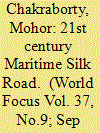

|
|
|
|
|
| Summary/Abstract |
The 21st Century Maritime Silk Road (MSR) is a cause for major concern in New Delhi as it provides a basis for Beijing to increase its geo-strategic footprint in the Indian Ocean. Notwithstanding the Chinese posture of allaying India’s concerns with respect to the massive outreach and implications of MSR, calling upon its neighbour to join the effort with a “friendly, open, cooperative attitude”, New Delhi has, naturally been cautious and calculative in making headway on the issue. Although Beijing had invited New Delhi to join the project in 2014, the Indian response has been negative.
|
|
|
|
|
|
|
|
|
|
|
|
|
|
|
|
| 2 |
ID:
147993
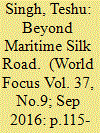

|
|
|
|
|
| Summary/Abstract |
The term Maritime Silk Road (MSR) was first used by Chinese President, Xi Jinping at the Asia Pacific Economic Cooperation summit held in Bali in 2013. Ever since then the MSR has become a major proposal of the new leadership in China. During Chinese Premier’s visit to Brunei, he announced the establishment of the China-ASEAN Maritime Cooperation Fund with USD 48 million allocated by China for sponsoring ASEAN-maritime cooperation projects. Further, to take this initiative forward China has set up a ten billion fund for this proposal.
|
|
|
|
|
|
|
|
|
|
|
|
|
|
|
|
| 3 |
ID:
147980
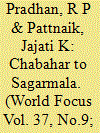

|
|
|
|
|
| Summary/Abstract |
India’s maritime space both externally and internally is under serious churning today. Caught between maritime forces and strategies building around South China Sea to Indo-Pacific region and the corresponding American ‘Asia Pivot’, India is riding maritime high table diplomacy in the neighbourhood sea lanes to protect and safeguard her strategic maritime assets and interests. Chabahar is one such India’s strategic naval diplomacy in the Persian Gulf. While the national and international media is agog with this maritime volatility and the corresponding stake holder countries moves and counter moves, India’s silent but strategic internal maritime space redrawing through ‘Sagarmala Project’ - India’s internal maritime connect grand strategy is not only a vision but a silent connectivity revolution in India’s coastal corridor towards an efficient maritime economy and efficiency.
|
|
|
|
|
|
|
|
|
|
|
|
|
|
|
|
| 4 |
ID:
147977
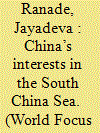

|
|
|
|
|
| Summary/Abstract |
Dominance of the South China Sea is not merely a territorial issue for China but, more importantly, one which it regards as a major step towards recognition as an unrivalled Asia-Pacific power that can arbitrate on global and regional issues along with the US. Since the 18th Congress of the Chinese Communist Party (CCP) and appointment of Xi Jinping simultaneously to China’s three top posts in November 2012, the world is witness to a new thrust to China’s already assertive foreign policy. Early in Xi Jinping’s term, China launched major, bold, geo-strategic initiatives aimed at expanding China’s diplomatic and economic influence and military power well beyond its frontiers.
|
|
|
|
|
|
|
|
|
|
|
|
|
|
|
|
| 5 |
ID:
147988


|
|
|
|
|
| Summary/Abstract |
‘Regionalism’ has emerged as the most important aspect of contemporary international relations. Across the world, the countries are preferring to form regional groups to achieve the goals of peace and development. Instead of being a grand global narrative, politics is increasingly becoming regionalized, resulting in significant changes in the power dynamics at both regional and global level. There are efforts to build up regional networks and infrastructure to expedite the processes of resource generation, mobilization and economic modernization. In Asia, however, the push towards regional integration runs into political tussle as the two major actors-China and India- try to counter each other and have parallel regional network projects.
|
|
|
|
|
|
|
|
|
|
|
|
|
|
|
|
| 6 |
ID:
147975
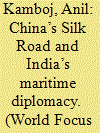

|
|
|
|
|
| Summary/Abstract |
The OBOR strategy has become China’s major foreign policy goal, Beijing will promote this initiative economically, politically, militarily and culturally over the next eight to ten years. For India, there are lessons from this. New Delhi also benefits from at least reasonable ties with most stakeholders in the New Silk Road, including Iran, where India has invested heavily in the Chabahar Port. But India must also make serious efforts to strengthen its links with Southeast Asia, and for this it must maintain stronger ties with Bangladesh. New Delhi will also need to work towards a manageable relationship with Pakistan, which would not only facilitate pipeline projects like TAPI, but also enable access to Afghanistan and Central Asia.
|
|
|
|
|
|
|
|
|
|
|
|
|
|
|
|
| 7 |
ID:
147997


|
|
|
|
|
| Summary/Abstract |
Indeed, India enjoys far greater influence in the Central Asia than China does and is a more acceptable role-player in addressing the security and economic concerns of the region. The Central Asian countries will also avoid firm alliances with world powers and, like India, will generally pursue policies of flexible alignment. India’s advantage is not location, and certainly not demographics, but its inherent and implicit pluralism.
|
|
|
|
|
|
|
|
|
|
|
|
|
|
|
|
| 8 |
ID:
147982
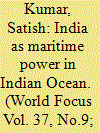

|
|
|
|
|
| Summary/Abstract |
India has inherited British regime, but failed to catch up some of the structures which were laid out by the regime. Independent India did not imagine of a strong naval base in Indian Ocean. The look east policy did initiate importance of Indian Ocean but remained confined to economic trade and commerce, the strategic insight remained missing. The current regime did start it innings with a strong dose of security and strategic concerns under the banner of Indian foreign policy. Three major thoughts were intertwined.
|
|
|
|
|
|
|
|
|
|
|
|
|
|
|
|
| 9 |
ID:
147985
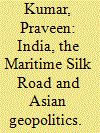

|
|
|
|
|
| Summary/Abstract |
Paul Kennedy, the author of The Rise and Fall of the Great Powers in one of his later works, entitled Preparing for the Twenty-First Century has argued that India and China can potentially do harm to themselves and the planet, given their rising population and limited resources. He has urged upon the developed world to “apply its capital, technology and brainpower to help them.” While there may be limitations to this argument, first being a western perspective and then on considerations such as with regards to the extent to which the developed world intends helping India and China, and to what extent India and China are willing to accept the terms, if any, of that help, but one thing that the author has highlighted is of significance. This pertains to the likely ‘conflict of interests’ over common resources and market between the two countries.
|
|
|
|
|
|
|
|
|
|
|
|
|
|
|
|
| 10 |
ID:
147986
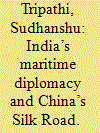

|
|
|
|
|
| Summary/Abstract |
India, while clinching on its rechristened Look East Policy, must act towards evolving a regional bonding of greater Asia as a regional bulwark against the backdrop of mounting tensions in the Indo-Pacific region due to rising Chinese expansionist assertions based on bullying tactics of its awesome military power, accompanied by economic allurements under its silk road initiative in Central Asia and string of pearls scheme in littoral regions of Indian Ocean and adjoining areas with ultimate purpose of establishing its hegemony all over the world. In this scenario, India needs to strengthen its strategic relations with all the littoral countries around its maritime zone and beyond to include all Southeast Asian nations, Persian-gulf, West Asia and African continent so as to strengthen and consolidate its maritime diplomacy and consequent naval strategy.
|
|
|
|
|
|
|
|
|
|
|
|
|
|
|
|
| 11 |
ID:
147991


|
|
|
|
|
| Summary/Abstract |
In sum, West Asia is a very significant region for India’s maritime diplomacy in general and the Gulf Cooperation Council in particular because India is dependent for its large part of energy requirements in the region, and similarly, the security of waterways in West Asia has also become the need of hour for India to create a maritime security mechanism for its geo-political and economic interests. In the era of globalization, the goods have been trading by the sea-routes because of the low costs in transportation, and therefore, the importance of sea-routes is also growing steadily, and consequently, the countries of the world want to use sea lines of communications for their trade and shipping activities.
|
|
|
|
|
|
|
|
|
|
|
|
|
|
|
|
| 12 |
ID:
147978


|
|
|
|
|
| Summary/Abstract |
India’s maritime diplomacy is shaped as much by its own interests as it is in response to action of other nations .Even with multiple short comings India has advanced its maritime interests in the India Ocean, Arabian Sea and the Pacific Ocean. It wishes to use the seas for her own purpose while simultaneously preventing others from using them in ways that are to her disadvantage. It is not about naval power but “preservation, protection and promotion of maritime interests of the country” with a wide spectrum including political, economic and military power exerted through the use of the sea. But in future challenges will be more not only from traditional rivals but emerging economies across the region which needs a policy with futuristic vision
|
|
|
|
|
|
|
|
|
|
|
|
|
|
|
|
| 13 |
ID:
147981


|
|
|
|
|
| Summary/Abstract |
As India China turn their gaze seaward in search of prosperity and energy security, both have embarked on a naval build up unprecedented in the nation’s modern history. Both countries in earlier centuries participated in mercantile trade and had their association with Southeast and South Asian nations. Indian leadership and strategic experts have been trying to revive the grand old strategy of ‘Indian Ocean being regarded as British lake/Indian lake’, therefore commanding the entire region as maritime power. China’s contemporary leadership also sees their rise as economic, military, and naval power as merely the latest phase in a benign regional dominance that had its origins in the Ming era. India and China, both today are busy in their naval build-up and fierce diplomatic manoeuvres and are trying to prevail upon their neighbours/coastal nations not to align with external powers to balance them.
|
|
|
|
|
|
|
|
|
|
|
|
|
|
|
|
| 14 |
ID:
147987
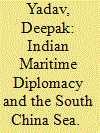

|
|
|
|
|
| Summary/Abstract |
South China Sea is a major waterway and over US$ 5 trillion trade passes through the sea lanes in this region. Over 55% of India’s trade passes through South China Sea. Peace and stability in the region is of great significance to India. India undertakes various activities, including cooperation in oil and gas sector, with littoral states of South China Sea. India supports freedom of navigation and over flight, and unimpeded commerce, based on the principles of international law, as reflected notably in the UNCLOS. India believes that States should resolve disputes through peaceful means without threat or use of force and exercise self-restraint in the conduct of activities that could complicate or escalate disputes affecting peace and stability. As a State Party to the UNCLOS, India urges all parties to show utmost respect for the UNCLOS, which establishes the international legal order of the seas and oceans.
|
|
|
|
|
|
|
|
|
|
|
|
|
|
|
|
| 15 |
ID:
147995
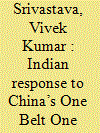

|
|
|
|
|
| Summary/Abstract |
Indian response to China’s One Belt One Road is well structured and is largely governed by the soft power approach. Chinese policy is solely dependent upon the economic interests whereas the India policy starts with soft power diplomacy but is also aimed to reach to develop the close economic-political relationships with the targeted countries. Indian response is more practical and is based on the understanding the needs of the concerned countries. The start has been made with simple efforts as the maritime cooperation, interaction at the trade discussion level.
|
|
|
|
|
|
|
|
|
|
|
|
|
|
|
|
| 16 |
ID:
147983


|
|
|
|
|
| Summary/Abstract |
Pain to the pain givers, should be the strategy of present India as the neighbours who always troubled and betrayed India are in trouble. Time has gone when India took pride in teaching ethics to the countries. They considered India as a banana republic and a moral teacher and thus did not give any importance either in regional or in international matters of importance. Most opportune time has come when India can exert pressure on its deaf neighbours and achieve the things it qualifies for. Once lost this opportunity, these opportunists will never be in India’s nest.
|
|
|
|
|
|
|
|
|
|
|
|
|
|
|
|
| 17 |
ID:
147984
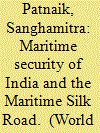

|
|
|
|
|
| Summary/Abstract |
The rise of China in Asia’s maritime security architecture is playing a determinant factor for India to define its strategic interests and review its maritime policy. For the first time Indian government document formally acknowledged the implications of the evolving and increasingly accepted concept of the “Indo-Pacific” on India’s maritime security. The geographic extent of this concept with its multiple variations essentially brings the Indian Ocean and the Western Pacific — theaters of geo-political competition — into one strategic arc.
|
|
|
|
|
|
|
|
|
|
|
|
|
|
|
|
| 18 |
ID:
147996


|
|
|
|
|
| Summary/Abstract |
To quote Sir Julian Corbett, the real point of sea power is not so much what happens at sea, but how that influences the outcome of events on land. The MSR’s essential rationale is the leveraging of Chinese soft-power. The aim apparently is to shore-up China’s image as a benevolent state. Beijing’s would also conceivably use the project’s commercial investments to establish its legitimate interests in the Indian Ocean. And while China can be expected to do everything in its power to force region states to join the project - including offering economic aid to potential partners - the bottom-line for it will be to make an offer to India that is hard to refuse. India’s appreciation of the MSR must be based on an objective appraisal of these new realities.
|
|
|
|
|
|
|
|
|
|
|
|
|
|
|
|
| 19 |
ID:
147979
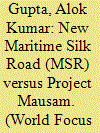

|
|
|
|
|
| Summary/Abstract |
Alfred Thayer Mahan in his book The Influence of Sea Power upon History 1660-1783 most famously presented his concept of ‘sea power’ which was based on the idea that countries with greater naval power will have greater worldwide impact. His concept had an enormous influence in shaping the strategic thought of navies across the world, especially those of United States, Germany, Japan and Great Britain. His concept ultimately led to European naval arms race in the 1890s. It was indeed a revolutionary analysis of the importance of naval power as a factor in the rise of the British Empire. Mahan’s argument that British control over the seas, combined with a corresponding decline in the naval strength of its major European rivals paved the way for Great Britain’s emergence as the world’s dominant military, political and economic power.
|
|
|
|
|
|
|
|
|
|
|
|
|
|
|
|
| 20 |
ID:
147992


|
|
|
|
|
| Summary/Abstract |
In the context of India’s Strategic Environment, often consideration of the intellectuals is that, “it is in the vicinity of the Indian Ocean concavity absolutely”. In this regard the explanations about India’s strategic proximity stretches to the Strait of Hormoz and the Persian Gulf in the west; according to some claims the eastern coast of Africa as the western-most border of this strategic arena. In the space capacity to the east, India’s neighbouring strategic zone includes the Strait of Malacca and extends up to the South China Sea. In the vertical block sector, the north is constituted of Central Asia, and to the south, it reaches out to Antarctica.
|
|
|
|
|
|
|
|
|
|
|
|
|
|
|
|
|
|
|
|
|